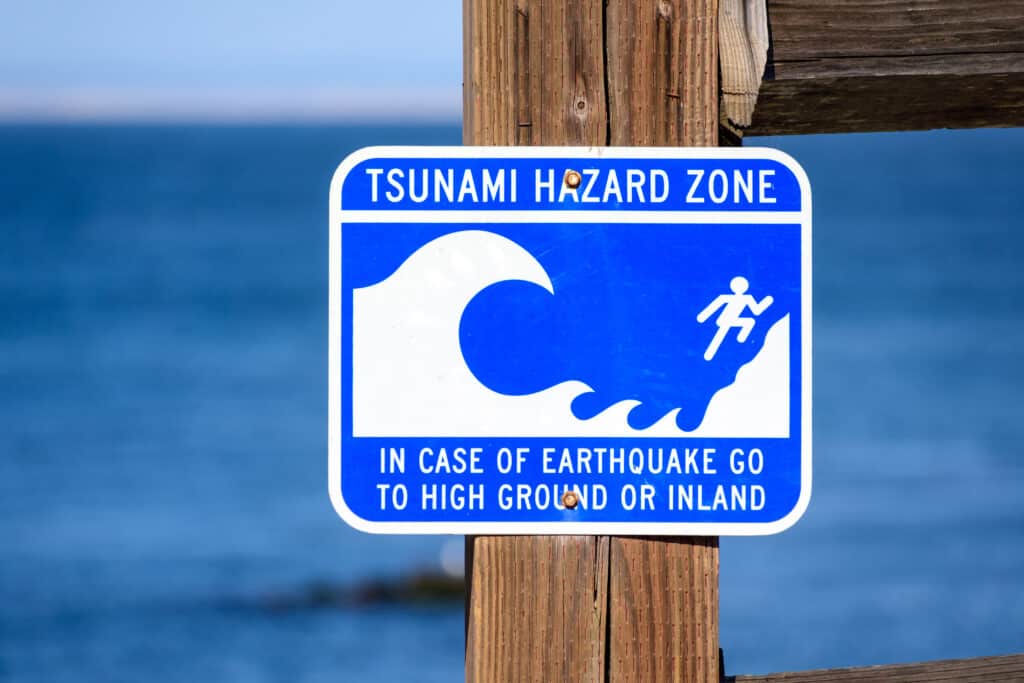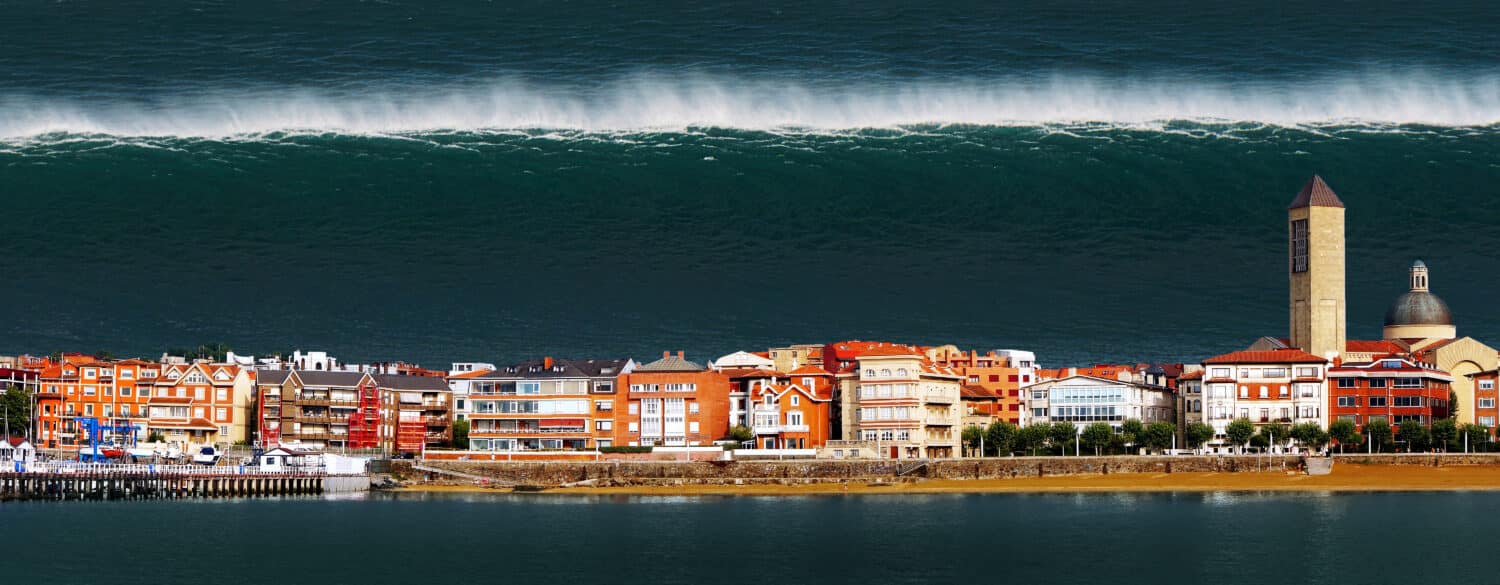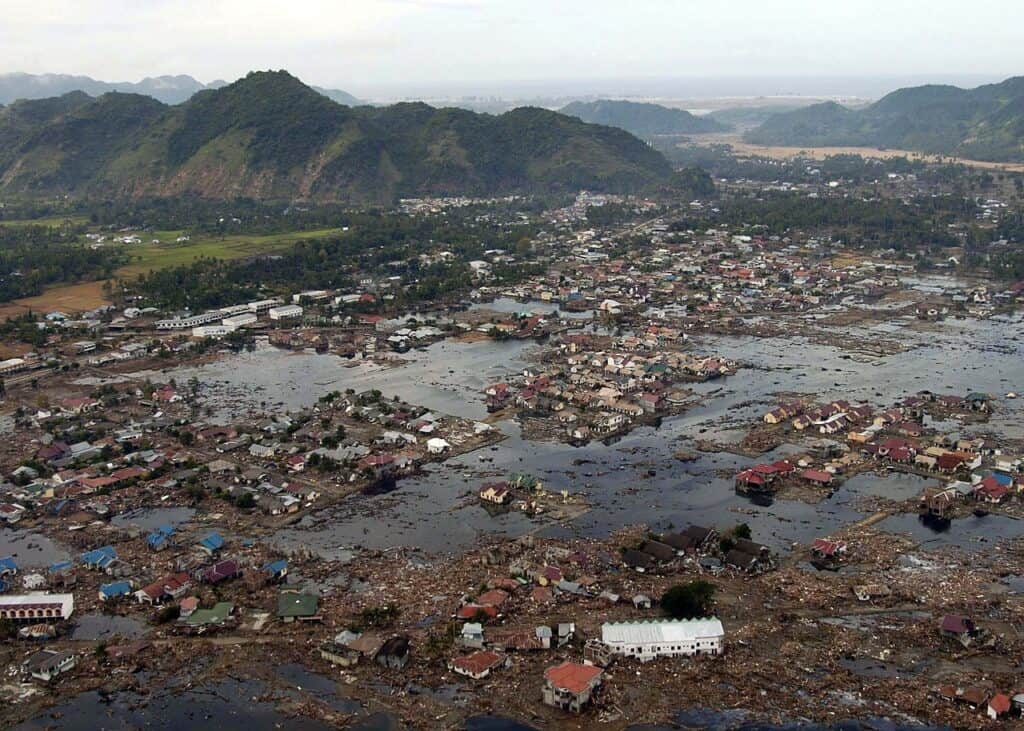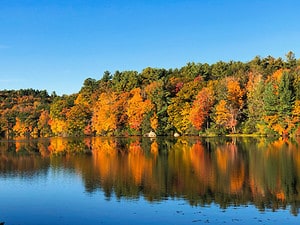New Zealand is a country surrounded by water and located on the Pacific Ring of Fire, a zone of high seismic and volcanic activity. For anyone familiar with the Ring of Fire, that is an immediate tip that the region is vulnerable to lots of seismic activity, and subsequently, tsunamis. Tsunamis can pose a serious threat to life and property along the coast, especially if they strike without warning. Today, we are going to explore some facts, risks, and how to prepare for tsunamis in New Zealand.
Can Tsunamis Happen in New Zealand?

Signs like this indicate that people should immediately go to higher ground in the event of an
earthquake.
, which could lead to a tsunami.
©Michael Vi/Shutterstock.com
Yes, tsunamis can happen in New Zealand from both local and distant sources. Local sources are earthquakes or other events that occur near the coast or offshore, within a few hundred kilometers of New Zealand. These tsunamis can arrive within minutes and can be devastating to coastal communities. Distant sources are earthquakes or other events far from New Zealand, such as in South America, Japan, or Alaska. These tsunamis can take hours to reach New Zealand and may affect the entire coastline since the wave has time to spread out (although that’s a bit of a simplification of how it actually works).
How Many Tsunamis Have Been Recorded in New Zealand?
According to historical records and scientific studies, New Zealand has been affected by at least 24 tsunamis with a wave height greater than one meter since 1855. Some of these tsunamis were caused by local earthquakes:
- The 1855 Wairarapa earthquake which lifted parts of Wellington Harbour
- The 1947 Gisborne earthquake which flooded parts of Gisborne city
- The 2016 Kaikoura earthquake which triggered a small tsunami along the east coast
Some were caused by distant earthquakes:
- The 1868 Peru earthquake which killed one person in Chatham Islands
- The 1960 Chile earthquake which damaged boats and buildings in several places
- The 2011 Japan earthquake which caused minor flooding and erosion in some areas
Even further, some were caused by other events, such as undersea landslides, volcanic eruptions, or meteor impacts, and are recorded on various online databases. There are lots of ways that tsunamis can occur, and New Zealand has pretty much seen a tsunami from any and all potential methods.
The Worst Tsunami to Ever Hit New Zealand

The deadliest tsunami in oral history occurred in the 15th century, but the deadliest in recent history occurred in 1868.
©Mimadeo/Shutterstock.com
The worst tsunami to ever hit New Zealand is not well known, but it may have occurred around the 15th century. According to Maori traditions and research, a massive wave wiped out an entire village on D’Urville Island in Marlborough Sounds. The wave may have been triggered by a “megathrust” earthquake on the southern Hikurangi Margin, a subduction zone where the Pacific Plate dives under the Australian Plate. The tsunami may have reached over 10 meters tall in some places and hit hundreds of kilometers of coastline. In fact, the devastation was so bad that it may have permanently shifted the locations where Maori villages were built, from low-lying coastal regions to higher hills.
The deadliest tsunami in “recent” history occurred on August 13th, 1868 when a massive earthquake with a magnitude between 8.5 to 9.3 struck near South America. The earthquake ruptured 600 km of the seafloor and generated a powerful tsunami that shot across the Pacific Ocean. The tsunami reached New Zealand 15 hours later and hit the Chatham Islands and Banks Peninsula with waves up to 10 meters high. The tsunami killed one person on the Chatham Islands and washed away several houses, boats, and bridges. It also caused strong currents and surges along the east coast of New Zealand, damaging coastal infrastructure and eroding beaches. The 1868 tsunami was the only one known to have killed anyone in New Zealand since the arrival of Europeans and is still distinctly remembered for its destruction.
How to Prepare for a Tsunami in New Zealand

It’s important to be prepared for a tsunami if you live in a high-risk area.
©U.S. Navy photo by Photographer’s Mate 2nd Class Philip A. McDaniel / public domain
There are a few general rules to follow in case of a tsunami that are true almost anywhere (like don’t go near the coastline), but every country has its own process and warning system to be aware of. These are pulled (and simplified) directly from the official New Zealand website (Get Ready):
- Learn your evacuation zones and routes. Check the NEMA or local Civil Defence websites.
- Make an emergency plan and a grab bag with essentials. Include food, water, clothes, meds, radio, torch, and phone.
- Listen to official warnings and advice. Do what local authorities say.
- Watch for natural signs of a tsunami, like a big quake, weird sea noises, or water going up or down. If you see any, go to high ground or inland fast. Long or Strong, Get Gone.
The photo featured at the top of this post is © iStock.com/jfoltyn
Thank you for reading! Have some feedback for us? Contact the AZ Animals editorial team.






